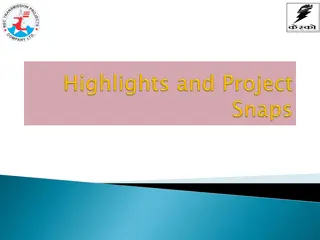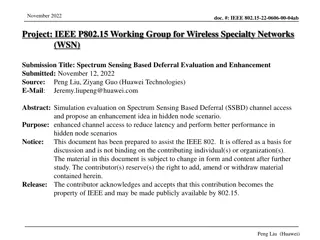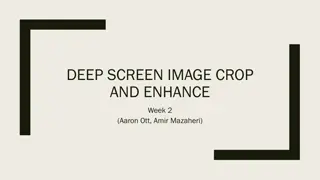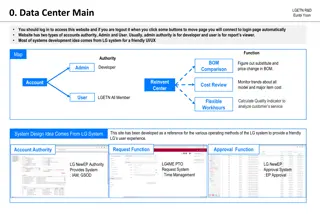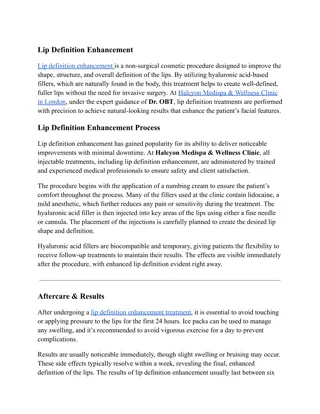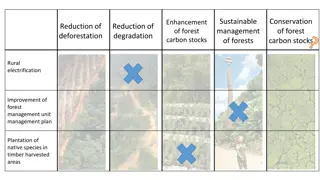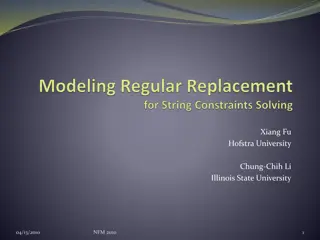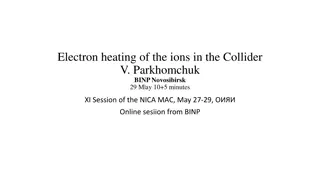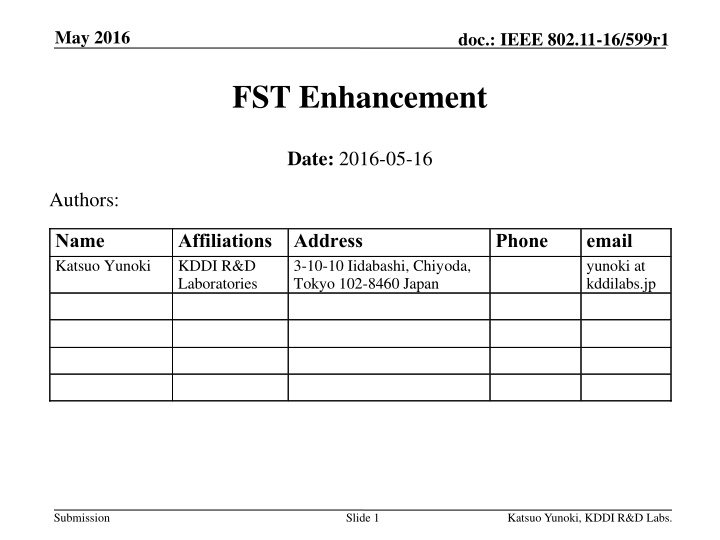
IEEE 802.11-16/599r1 FST Enhancement Presentation Analysis
Explore the presentation on FST enhancement in IEEE 802.11-16/599r1, addressing issues like severe propagation fluctuations in public spaces, multi-band operation, and traffic categorization for optimal performance. The slides delve into scenarios, protocols, and setup procedures, offering insights for improving wireless communication technologies.
Download Presentation

Please find below an Image/Link to download the presentation.
The content on the website is provided AS IS for your information and personal use only. It may not be sold, licensed, or shared on other websites without obtaining consent from the author. If you encounter any issues during the download, it is possible that the publisher has removed the file from their server.
You are allowed to download the files provided on this website for personal or commercial use, subject to the condition that they are used lawfully. All files are the property of their respective owners.
The content on the website is provided AS IS for your information and personal use only. It may not be sold, licensed, or shared on other websites without obtaining consent from the author.
E N D
Presentation Transcript
May 2016 doc.: IEEE 802.11-16/599r1 FST Enhancement Date: 2016-05-16 Authors: Name Katsuo Yunoki Affiliations Address KDDI R&D Laboratories Phone email yunoki at kddilabs.jp 3-10-10 Iidabashi, Chiyoda, Tokyo 102-8460 Japan Submission Slide 1 Katsuo Yunoki, KDDI R&D Labs.
May 2016 doc.: IEEE 802.11-16/599r1 Background Propagation fluctuation will be severe and drastic in public space and/or outdoor environment due to blocking or multipath by pedestrians, reflections, or sometimes cars in 11ay use scenario. 2.4/5GHz band could compensate some part of degradation in 60GHz performance. Submission Slide 2 Katsuo Yunoki, KDDI R&D Labs.
May 2016 doc.: IEEE 802.11-16/599r1 Use Scenario Video/Mass-data distribution/VOD It supposes severe/drastic propagation fluctuation due to frequent blocking at public and/or outdoor environment. mmW Internet user contents server Dining-Hall Exhibition 5GHz pedestrians Outdoor deployment Throughput Backhaul @60GHz mmW mmW only 11ay AP 11ay AP Base BW by 5GHz N-LOS Access LOS Access Time Time BUS STOP Traffic split by multi-link with 2.4/5GHz may moderate this issue. It could maintain part of traffic. Wireless backhauling with single hop Submission Slide 3 Katsuo Yunoki, KDDI R&D Labs.
May 2016 doc.: IEEE 802.11-16/599r1 10.32 Multi-band operation (Std. 802.11ad-2012) In 2nd paragraph on page 395: The FST session transition is managed by FST session setup protocol. ~(omitted)~ Depending on the STA s behavior during the FST session setup, the FST session can be operational in one band, or may be transferred to another band, or channel in the same band, or can be operational in multiple bands and/or channels simultaneously ~(omitted)~. If a multi-band capable device is operational in more than one band/channel simultaneously, the STA may use the FST session setup protocol to change the operation to a single channel. Simultaneous communication in multiple bands/channels is already addressed in the existing standard. Katsuo Yunoki, KDDI R&D Labs. Submission Slide 4
May 2016 doc.: IEEE 802.11-16/599r1 Fig. 10-33 Procedure of the FST setup protocol Old band (e.g. 60GHz) New band (e.g. 5GHz) New band (e.g. 5GHz) Old band (e.g. 60GHz) The new band will be set up after this protocol completion. FST Setup Request frame The old band could be used along with the new band at the same time. However, it s not clarified how that multi-link can be enabled by this protocol. FST Setup Response frame FST Ack Request frame FST TS switching (10.32.2.3,11ad std.) is defined for indicating which streams are to be transferred to the other band. It depends on AC of EDCA. FST Ack Response frame Submission Slide 5 Katsuo Yunoki, KDDI R&D Labs.
May 2016 doc.: IEEE 802.11-16/599r1 Typical traffic in TGay use scenario FTP could be one of typical traffic in 11ay use scenario. AC is Best Effort? or Video? It s just either one, anyway. How to categorize each application traffic to AC is another issue. The current FST cannot split a traffic stream just into multiple bands. When 60GHz will be blocked, the stream will be interrupted in 60GHz and transferred to 5GHz. Multi-link operation with 2.4/5GHz may moderate this stream interruption. It could have base bandwidth. There might be issues on upper layer flow control in multi-link connection. However, setup for multi-link on lower layer should be addressed more clearly for an option in the Std. Movie file Contents server 60GHz + 5GHz FTP? Submission Slide 6 Katsuo Yunoki, KDDI R&D Labs.
May 2016 doc.: IEEE 802.11-16/599r1 Summary Severe/drastic propagation fluctuation may be compensated by always-simultaneous multi-band operation. It could be an option of FST. Submission Slide 7 Katsuo Yunoki, KDDI R&D Labs.
May 2016 doc.: IEEE 802.11-16/599r1 Straw Poll / Motion Do you support to add the following text into the 11ay SFD? 11ay amendment addresses FST enhancement to enable multi-link operation to split and transfer traffic stream into multiple bands/channels simultaneously. Result: Y/N/A= Submission Slide 8 Katsuo Yunoki, KDDI R&D Labs.
May 2016 doc.: IEEE 802.11-16/599r1 References doc. IEEE802.11-15/625r3, IEEE802.11 TGay Use Cases IEEE Std. 802.11ad-2012 IEEE Std. 802.11-2012 Submission Slide 9 Katsuo Yunoki, KDDI R&D Labs.
May 2016 doc.: IEEE 802.11-16/599r1 Appendix Submission Slide 10 Katsuo Yunoki, KDDI R&D Labs.
May 2016 doc.: IEEE 802.11-16/599r1 10.32.2.3 FST TS switching (TS stands for Traffic Stream) If a STA transmitting an FST Setup Request or an FST Setup Response does not intend to switch all its streams, then the STA shall include the Switching Stream element in the transmitted frame to indicate which streams are requested to be transferred to the other band/channel. Switching Stream element The TID subfield specifies the stream in the corresponding band. It identifies TC (Traffic Category) or TS (Traffic Stream) to which the corresponding or AMSDU in the Frame Body field belongs. . This FST TS switching is depending on TID (AC in EDCA). Submission Slide 11 Katsuo Yunoki, KDDI R&D Labs.



